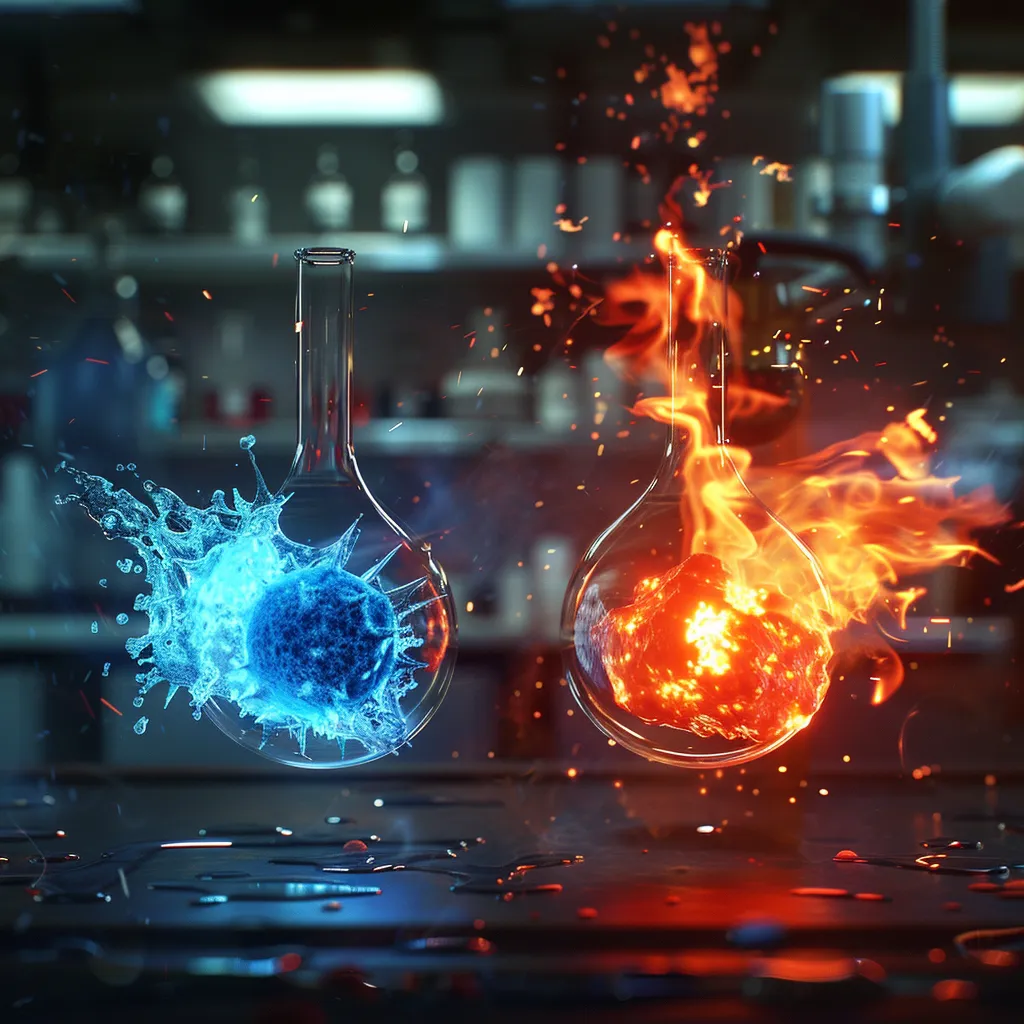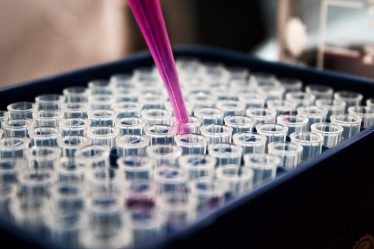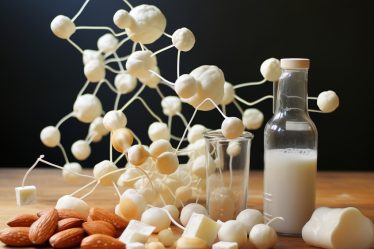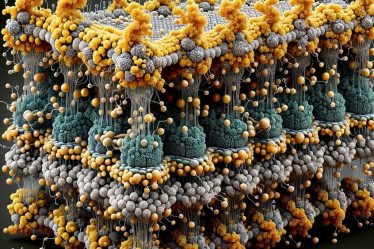
In every chemical reaction, energy is absorbed or released, affecting the surrounding temperature. Exothermic reactions release heat, making the surroundings warmer, while endothermic reactions absorb heat, cooling the environment.
The reaction type depends on whether energy is released or absorbed during bond formation and breaking. This process is seen in everyday phenomena like combustion, photosynthesis, and refrigeration.
Let’s explore these reactions through clear explanations and practical examples.
Exothermic and Endothermic Reaction: Quick Summary
Do you just need the basics? Here’s a simple explanation of what are exothermic and endothermic reactions:
🟠 Exothermic reactions release energy as heat, increasing the temperature of their surroundings.
🟠 Endothermic reactions absorb heat, resulting in a drop in temperature in their environment.
🟠 Real-world examples of exothermic reactions include combustion and rusting, while photosynthesis and evaporation are common endothermic processes.
🟠 In reversible reactions, energy can flow between exothermic and endothermic phases depending on external conditions.
If you find exothermic endothermic reactions challenging, don’t worry! Personalized tutoring or interactive chemistry lessons make these concepts more straightforward. Explore more chemistry topics and broaden your knowledge with our free World of Chemistry blogs.
What Are Exothermic and Endothermic Reactions?
Exothermic and endothermic reactions describe how energy is transferred during chemical processes.
In exothermic reactions, energy is released into the surroundings, often as heat, making the environment feel warmer. In endothermic reactions, energy is absorbed, which cools the surroundings.
Exothermic and endothermic reactions play a vital role in everyday life, from burning fuels for energy, to how plants produce food through photosynthesis, and in refrigeration systems that regulate temperature by absorbing or releasing heat.
Tracking how energy flows between reactants and the environment helps predict how a reaction will behave.
How Energy Changes in Reactions Affect Heat Exchange
The changes in energy during chemical reactions are driven by the breaking and forming chemical bonds. When bonds break, energy is absorbed, making the process endothermic. Conversely, when new bonds form, energy is released, making it exothermic.
The overall energy change in a reaction is determined by comparing the energy needed to break bonds with the energy released when new bonds form. If more energy is released than absorbed, the reaction is exothermic. If more energy is absorbed, it is endothermic.
Exothermic and Endothermic Reaction Examples:
Exothermic Reaction: When natural gas (methane) burns, it releases energy in the form of heat:
CH₄ + 2O₂ → CO₂ + 2H₂O + heat
Endothermic Reaction: In photosynthesis, plants absorb sunlight to convert water and carbon dioxide into glucose:
6CO₂ + 6H₂O + heat → C₆H₁₂O₆ + 6O₂
Identifying Exothermic and Endothermic Reactions
To classify a reaction as exothermic or endothermic, you can observe several factors. The most obvious indicator is temperature change. In exothermic reactions, the surrounding temperature rises, while in endothermic reactions, it drops. Other signs include phase changes (melting or freezing) and the reaction’s effect on the environment.
Indicators of Exothermic Reactions:
- Heat release (e.g., combustion)
- Increase in surrounding temperature
- Emission of light or sound in some cases
Indicators of Endothermic Reactions:
- Heat absorption (e.g., ice packs)
- Decrease in surrounding temperature
- Reaction feels cold to the touch
Difference between an Exothermic and Endothermic Reaction
| Type of Reaction | Energy Flow | Example | Observable Effect |
| Exothermic Reaction | Releases heat | Combustion of methane | Surroundings warm-up |
| Endothermic Reaction | Absorbs heat | Photosynthesis, Ice Pack Reaction | Surroundings cool down |
Exothermic Reactions: Release of Heat in Chemical Processes
Exothermic reactions release energy, typically in the form of heat, into their surroundings. These reactions are essential in natural and industrial applications, from simple combustion in your home heater to large-scale chemical manufacturing.
The release of energy during these reactions is the result of the bond formation process, which allows more energy to be emitted than was required to initiate the reaction.
How Exothermic Reactions Release Energy
In an exothermic reaction, energy is released when new bonds form after old ones are broken. The energy required to break the initial bonds is less than the energy released when the new bonds form. This excess energy is released into the surroundings, typically as heat.
Exothermic Reaction Examples
Exothermic reactions are quite common. They can happen rapidly, such as in combustion, or slowly, like in the rusting of metals. Exothermic reactions release energy in various ways, depending on the nature of the chemical process.
Exothermic Reaction: Combustion
The combustion of methane or gasoline is a rapid exothermic reaction where fuel reacts with oxygen, releasing heat. For example, burning methane:
CH₄ + 2O₂ → CO₂ + 2H₂O + heat
This reaction releases significant energy, powering engines and heating homes.
Exothermic Reaction: Oxidation
A slower exothermic reaction, such as the oxidation of iron (rust formation), releases heat over time:
4Fe + 3O₂ → 2Fe₂O₃ + heat
While the heat output is minimal, it’s still an exothermic process.
Exothermic Reaction: Cellular Respiration
In living organisms, the breakdown of glucose in the presence of oxygen is an exothermic process that produces energy for cells:
C₆H₁₂O₆ + 6O₂ → 6CO₂ + 6H₂O + heat
Cellular respiration provides essential energy for biological functions.
Energy Flow in Exothermic Reactions
In exothermic reactions, the energy released can vary in intensity depending on the bonds involved. For example, the combustion of fuels releases a large amount of heat in a short time, while slower processes like rusting release energy more gradually.
Energy Diagrams of Exothermic Reactions
Energy diagrams show how energy flows during exothermic reactions. In these diagrams, the energy level of the reactants is higher than that of the products, showing that energy is released as heat.
Key Points of Exothermic Energy Diagrams:
- Reactants start at a higher energy level than the products.
- The energy difference between reactants and products equals the heat released.
- The peak of the diagram represents the activation energy needed to start the reaction, but the energy released far exceeds the energy required.
In combustion, the energy needed to break the fuel and oxygen bonds is quickly surpassed by the energy released when new bonds form in the products, causing significant heat release.
Endothermic Reactions: Absorption of Heat in Chemical Processes
Endothermic reactions are chemical processes where energy is absorbed from the surroundings, causing the temperature to drop. This absorbed energy breaks chemical bonds, making these reactions critical in many natural and industrial processes.
Energy Absorption in Endothermic Reactions
In endothermic reactions, energy is taken in to break bonds within molecules.
For example, photosynthesis is a well-known process where plants absorb sunlight to convert carbon dioxide and water into glucose and oxygen:
6CO₂ + 6H₂O + heat → C₆H₁₂O₆ + 6O₂
Another everyday example is evaporation, where water absorbs heat to turn from a liquid into vapor. The energy breaks the hydrogen bonds between water molecules, allowing them to escape into the air as gas.
Endothermic Reaction Examples
Besides photosynthesis and evaporation, another example is the reaction between barium hydroxide and ammonium chloride. This process absorbs heat from the environment, cooling the reaction mixture:
Ba(OH)₂ · 8H₂O (s) + 2NH₄Cl (s) → BaCl₂ (aq) + 2NH₃ (g) + 10H₂O (l)
Endothermic reactions are also used in industrial processes such as electrolysis, where electricity is used to break chemical bonds, as in splitting water into hydrogen and oxygen.
Energy Diagrams of Endothermic Reactions
Energy diagrams for endothermic reactions show that the products are at a higher energy level than the reactants. The energy absorbed increases the system’s overall energy, which is represented by a positive change in enthalpy (ΔH).
Diagrams also show the activation energy required to start the reaction, demonstrating the energy needed to break bonds and absorb heat during the reaction.
Enthalpy and Activation Energy in Reactions
Enthalpy and activation energy are two important factors that determine how reactions occur and how fast they proceed. Enthalpy measures the heat change during a reaction, while activation energy is the minimum energy required for a reaction to start.
Calculating Enthalpy Changes in Reactions
The change in enthalpy (ΔH) shows whether a reaction releases or absorbs energy.
When ΔH is negative, heat is released, making the reaction exothermic. A positive ΔH means heat is absorbed, indicating an endothermic reaction.
To calculate ΔH, use the formula:
ΔH = ∑ΔH(products) – ∑ΔH(reactants)
For example, in methane combustion:
CH₄ + 2O₂ → CO₂ + 2H₂O
You subtract the enthalpy of the reactants from the products to determine whether energy is absorbed or released.
Activation Energy and Its Effect on Reaction Speeds
Activation energy is the amount of energy needed to start a reaction. The higher the activation energy, the slower the reaction proceeds. If the energy barrier is lower, the reaction happens more quickly.
For instance, in many biological reactions, enzymes act as catalysts to lower the activation energy, allowing essential processes like digestion to happen faster. Lowering activation energy is key to speeding up reactions that would otherwise take too long to occur naturally.
Enthalpy and activation energy determine the energy changes and speed of reactions, helping us predict their behavior in different conditions.
Reversible Reactions: Balancing Exothermic and Endothermic Processes
Reversible reactions can shift between releasing and absorbing energy, depending on the conditions. In these processes, exothermic and endothermic phases occur as the reaction moves in different directions. Tracking energy flow through these reactions helps predict their behavior under changing conditions.
Energy Flow in Reversible Reactions
In reversible reactions, energy shifts between exothermic and endothermic phases. When moving in the forward direction, the reaction may release heat (exothermic). However, when reversed, the same reaction absorbs heat (endothermic).
This continuous exchange of energy maintains a balance, allowing the reaction to proceed in both directions under the right conditions.
Equilibrium in Exothermic and Endothermic Reactions
Equilibrium occurs when the rates of the forward and reverse reactions are equal. Temperature significantly affects this balance.
If the reaction absorbs heat (endothermic), increasing the temperature favors the forward direction. In contrast, for an exothermic reaction, reducing the temperature shifts the equilibrium towards the products.
Advance Your Knowledge in Endothermic Exothermic Reactions
Are endothermic and exothermic reactions tricky for you? A qualified chemistry instructor can explain complex topics in a way that makes sense to you, making organic and inorganic chemistry understandable and enjoyable.
Search for a tutor using phrases like “organic chemistry tutor Liverpool” or “inorganic chemistry teacher Edinburgh” on platforms like meet’n’learn. You’ll find someone who can tailor lessons to your needs.
If you prefer learning in a group, search for “chemistry classes Leeds” or “chemistry lessons London” online. The search will lead you to chemistry tutoring nearby.
Endothermic and Exothermic Reactions: Frequently Asked Questions
1. What are exothermic reactions?
Exothermic reactions release energy in the form of heat, causing the surroundings to warm up.
2. What are endothermic reactions?
Endothermic reactions absorb heat from their surroundings, resulting in a decrease in temperature.
3. How do you identify an exothermic reaction?
Exothermic reactions can be identified by a noticeable increase in temperature or heat release during the process.
4. What is an example of an endothermic reaction?
Photosynthesis, where plants absorb sunlight to produce glucose and oxygen, is a classic endothermic reaction.
5. How do exothermic reactions occur in daily life?
Common exothermic reactions include combustion, such as burning fuel in engines and rusting of metals.
6. What happens to energy during an endothermic reaction?
During an endothermic reaction, energy is absorbed from the surroundings, cooling the environment around the reaction.
7. Can a reaction be both exothermic and endothermic?
In reversible reactions, different phases can shift between exothermic and endothermic, depending on the conditions.
8. How do temperature changes impact exothermic and endothermic reactions?
Raising the temperature speeds up endothermic reactions while lowering it favors exothermic reactions, especially in reversible processes.
References:
1. Khan
2. ChemLibre Texts
3. Wikipedia



